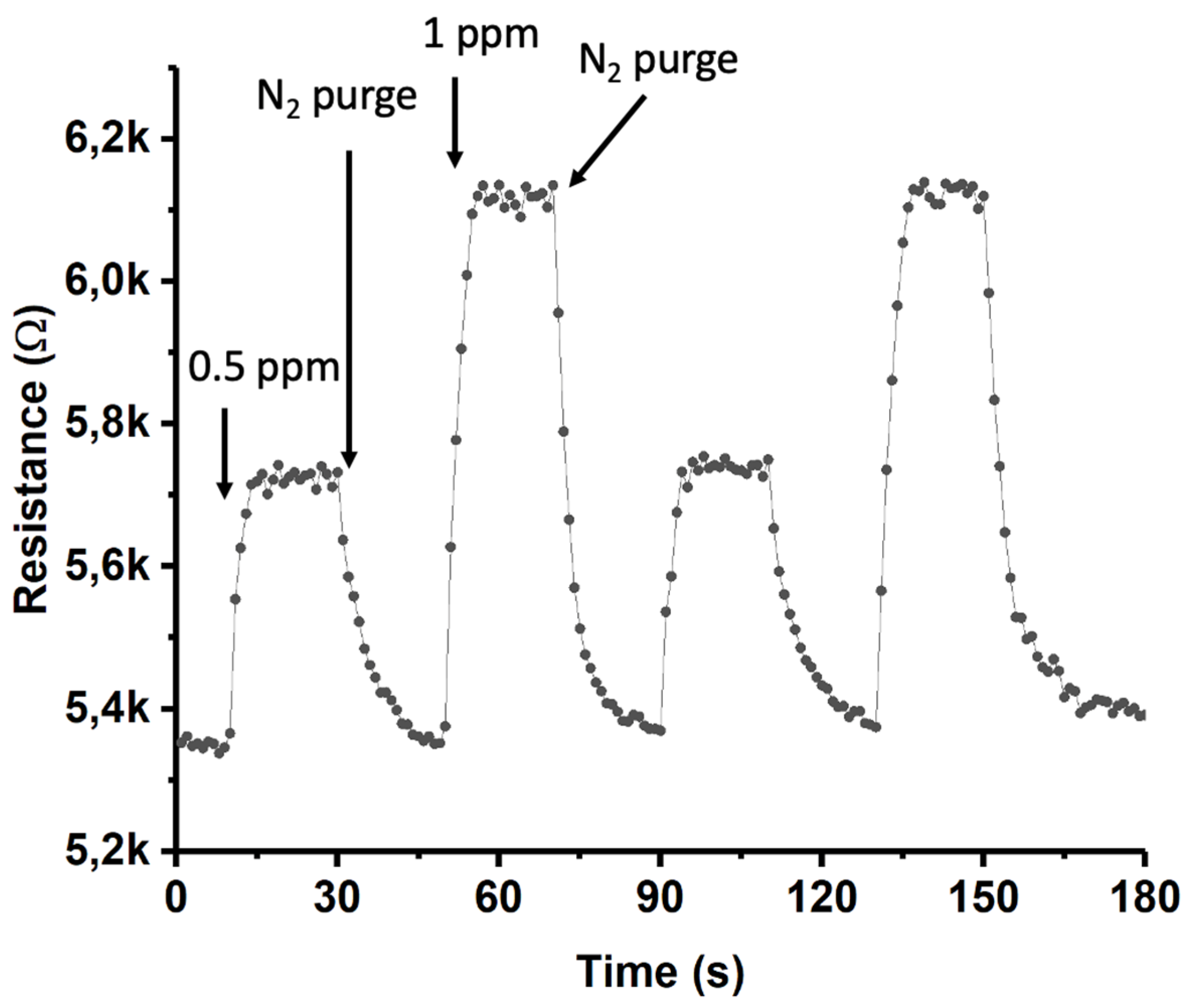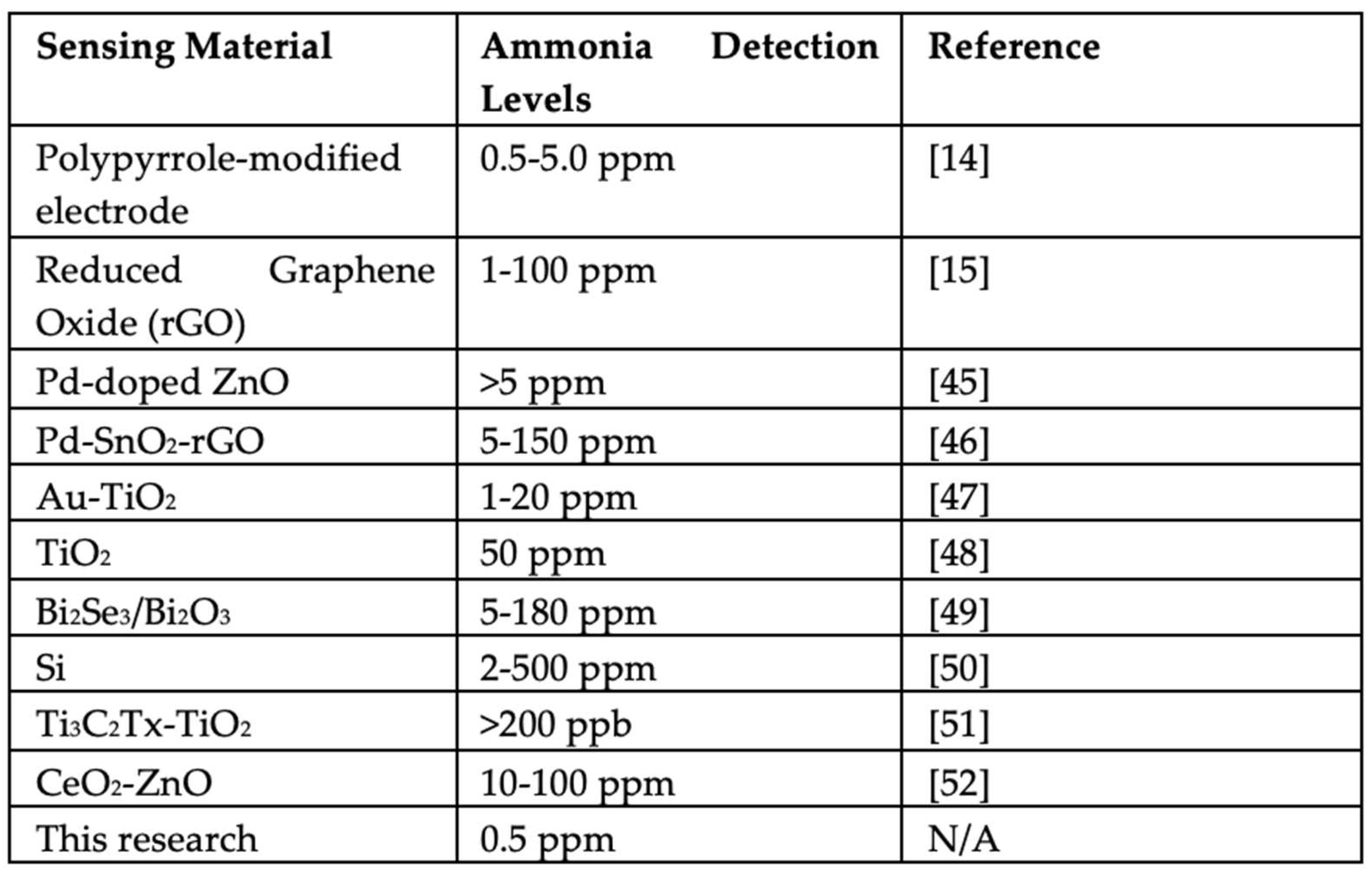Submitted:
09 April 2023
Posted:
11 April 2023
You are already at the latest version
Abstract
Keywords:
1. Introduction
2. Materials and Methods
2.1. Preparation of Substrates for SWCNTs Growth
2.2. Synthesis of SWCNTs-SiO2-Si
2.3. Synthesis of Au@SWCNTs-SiO2-Si
2.4. Synthesis of MoS2-Au@SWCNTs-SiO2-Si
2.5. Characterization
2.6. Target Gas Exposure
3. Results and Discussion
3.1. Characterization of Nanomaterials
3.2. Assembly of the Device and Gas Sensing Properties
4. Conclusions
Supplementary Materials
Author Contributions
Funding
Institutional Review Board Statement
Informed Consent Statement
Data Availability Statement
Acknowledgments
Conflicts of Interest
References
- Li, X.; Li, X.; Li, Z.; Wang, J.; Zhang, J. WS2 Nanoflakes Based Selective Ammonia Sensors at Room Temperature. Sensors and Actuators B: Chemical 2017, 240, 273–277. [Google Scholar] [CrossRef]
- Wang, Y.; Liu, J.; Cui, X.; Gao, Y.; Ma, J.; Sun, Y.; Sun, P.; Liu, F.; Liang, X.; Zhang, T.; et al. NH3 Gas Sensing Performance Enhanced by Pt-Loaded on Mesoporous WO3. Sensors and Actuators B: Chemical 2017, 238, 473–481. [Google Scholar] [CrossRef]
- Kanan, S.; El-Kadri, O.; Abu-Yousef, I.; Kanan, M. Semiconducting Metal Oxide Based Sensors for Selective Gas Pollutant Detection. Sensors 2009, 9, 8158–8196. [Google Scholar] [CrossRef]
- Kwak, D.; Lei, Y.; Maric, R. Ammonia Gas Sensors: A Comprehensive Review. Talanta 2019, 204, 713–730. [Google Scholar] [CrossRef]
- Verma, A.; Gupta, R.; Verma, A.S.; Kumar, T. A Review of Composite Conducting Polymer-Based Sensors for Detection of Industrial Waste Gases. Sensors and Actuators Reports 2023, 5, 100143. [Google Scholar] [CrossRef]
- Baek, S.; Khazi, M.I.; Kim, J.-M. Colorimetric and Fluorometric Ammonia Sensor Based on Protonated Bipyridyl-Containing Polydiacetylene. Dyes and Pigments 2023, 215, 111254. [Google Scholar] [CrossRef]
- 7. Toxic FAQ Sheet of Ammonia; Agency for Toxic Substances and Disease Registry (ATSDR), 2004; CAS 7664-41-7.
- Tai, H.; Duan, Z.; He, Z.; Li, X.; Xu, J.; Liu, B.; Jiang, Y. Enhanced Ammonia Response of Ti3C2T Nanosheets Supported by TiO2 Nanoparticles at Room Temperature. Sensors and Actuators B: Chemical 2019, 298, 126874. [Google Scholar] [CrossRef]
- Tai, H.; Duan, Z.; Wang, Y.; Wang, S.; Jiang, Y. Paper-Based Sensors for Gas, Humidity, and Strain Detections: A Review. ACS Appl. Mater. Interfaces 2020, 12, 31037–31053. [Google Scholar] [CrossRef]
- Panes-Ruiz, L.A.; Shaygan, M.; Fu, Y.; Liu, Y.; Khavrus, V.; Oswald, S.; Gemming, T.; Baraban, L.; Bezugly, V.; Cuniberti, G. Toward Highly Sensitive and Energy Efficient Ammonia Gas Detection with Modified Single-Walled Carbon Nanotubes at Room Temperature. ACS Sens. 2018, 3, 79–86. [Google Scholar] [CrossRef]
- Mackin, C.; Schroeder, V.; Zurutuza, A.; Su, C.; Kong, J.; Swager, T.M.; Palacios, T. Chemiresistive Graphene Sensors for Ammonia Detection. ACS Appl. Mater. Interfaces 2018, 10, 16169–16176. [Google Scholar] [CrossRef]
- Tai, H.; Wang, S.; Duan, Z.; Jiang, Y. Evolution of Breath Analysis Based on Humidity and Gas Sensors: Potential and Challenges. Sensors and Actuators B: Chemical 2020, 318, 128104. [Google Scholar] [CrossRef]
- Ryu, H.; Thompson, D.; Huang, Y.; Li, B.; Lei, Y. Electrochemical Sensors for Nitrogen Species: A Review. Sensors and Actuators Reports 2020, 2, 100022. [Google Scholar] [CrossRef]
- Yavarinasab, A.; Janfaza, S.; Tahmooressi, H.; Ghazi, M.; Tasnim, N.; Hoorfar, M. A Selective Polypyrrole-Based Sub-ppm Impedimetric Sensor for the Detection of Dissolved Hydrogen Sulfide and Ammonia in a Mixture. Journal of Hazardous Materials 2021, 416, 125892. [Google Scholar] [CrossRef]
- Veluswamy, P.; Sathiyamoorthy, S.; P. , S.; Karunakaran, G.; Lee, C.W.; Kuznetsov, D.; Kadarkaraithangam, J.; Ikeda, H. Sono-Synthesis Approach of Reduced Graphene Oxide for Ammonia Vapour Detection at Room Temperature. Ultrasonics Sonochemistry 2018, 48, 555–566. [Google Scholar] [CrossRef]
- Ji, Y.; Duan, K.; Lu, Z.; Ren, W. Mid-Infrared Absorption Spectroscopic Sensor for Simultaneous and in-Situ Measurements of Ammonia, Water and Temperature. Sensors and Actuators B: Chemical 2022, 371, 132574. [Google Scholar] [CrossRef]
- Fu, H.; Zhang, J.; Ding, J.; Wang, Q.; Li, H.; Shao, M.; Liu, Y.; Liu, Q.; Zhang, M.; Zhu, Y.; et al. Ultra Sensitive NH3 Gas Detection Using Microfiber Bragg Grating. Optics Communications 2018, 427, 331–334. [Google Scholar] [CrossRef]
- Passaro, V.; Dell’Olio, F.; De Leonardis, F. Ammonia Optical Sensing by Microring Resonators. Sensors 2007, 7, 2741–2749. [Google Scholar] [CrossRef]
- Abdelaziz, O.A.; Abdallah, R.M.; Khater, R.A.; Abo Dena, A.S.; El-Sherbiny, I.M. Optical Ammonia-Sensing Probe Based on Surface-Plasmon Resonance of Silver-Nanoparticle-Decorated Superparamagnetic Dendritic Nanoparticles. Plasmonics 2023, 18, 201–212. [Google Scholar] [CrossRef]
- Ahmed, S.; Park, Y.; Okuda, H.; Ono, S.; Korposh, S.; Lee, S.-W. Fabrication of Humidity-Resistant Optical Fiber Sensor for Ammonia Sensing Using Diazo Resin-Photocrosslinked Films with a Porphyrin-Polystyrene Binary Mixture. Sensors 2021, 21, 6176. [Google Scholar] [CrossRef]
- Maierhofer, M.; Rieger, V.; Mayr, T. Optical Ammonia Sensors Based on Fluorescent Aza-BODIPY Dyes-a Flexible Toolbox. Anal Bioanal Chem 2020, 412, 7559–7567. [Google Scholar] [CrossRef]
- Lu, D.; Qi, Z. Optical Ammonia-Nitrogen Sensor With Wide Dynamic Measurement Range. In Proceedings of the 2019 IEEE SENSORS; IEEE: Montreal, QC, Canada, October, 2019; pp. 1–4. [Google Scholar]
- Fernández-Ramos, M.D.; Capitán-Vallvey, L.F.; Pastrana-Martínez, L.M.; Morales-Torres, S.; Maldonado-Hódar, F.J. Chemoresistive NH3 Gas Sensor at Room Temperature Based on the Carbon Gel-TiO2 Nanocomposites. Sensors and Actuators B: Chemical 2022, 368, 132103. [Google Scholar] [CrossRef]
- Nunes Simonetti, E.A.; Cardoso de Oliveira, T.; Enrico do Carmo Machado, Á.; Coutinho Silva, A.A.; Silva dos Santos, A.; de Simone Cividanes, L. TiO2 as a Gas Sensor: The Novel Carbon Structures and Noble Metals as New Elements for Enhancing Sensitivity—A Review. Ceramics International 2021, 47, 17844–17876. [Google Scholar] [CrossRef]
- Pereira, P.F.M.; de Sousa Picciani, P.H.; Calado, V.; Tonon, R.V. Electrical Gas Sensors for Meat Freshness Assessment and Quality Monitoring: A Review. Trends in Food Science & Technology 2021, 118, 36–44. [Google Scholar] [CrossRef]
- Zhao, Z.; Yang, H.; Wei, Z.; Xue, Y.; Sun, Y.; Zhang, W.; Li, P.; Gong, W.; Zhuiykov, S.; Hu, J. NH3 Sensor Based on 3D Hierarchical Flower-Shaped n-ZnO/p-NiO Heterostructures Yields Outstanding Sensing Capabilities at Ppb Level. Sensors 2020, 20, 4754. [Google Scholar] [CrossRef]
- Van Duy, L.; Nguyet, T.T.; Le, D.T.T.; Van Duy, N.; Nguyen, H.; Biasioli, F.; Tonezzer, M.; Di Natale, C.; Hoa, N.D. Room Temperature Ammonia Gas Sensor Based on P-Type-like V2O5 Nanosheets towards Food Spoilage Monitoring. Nanomaterials 2022, 13, 146. [Google Scholar] [CrossRef]
- Star, A.; Joshi, V.; Skarupo, S.; Thomas, D.; Gabriel, J.-C.P. Gas Sensor Array Based on Metal-Decorated Carbon Nanotubes. J. Phys. Chem. B 2006, 110, 21014–21020. [Google Scholar] [CrossRef]
- Datta, K.; Ghosh, P.; More, M.A.; Shirsat, M.D.; Mulchandani, A. Controlled Functionalization of Single-Walled Carbon Nanotubes for Enhanced Ammonia Sensing: A Comparative Study. J. Phys. D: Appl. Phys. 2012, 45, 355305. [Google Scholar] [CrossRef]
- Chen, X.; Chen, X.; Ding, X.; Yu, X.; Yu, X. Enhanced Ammonia Sensitive Properties and Mechanism Research of PANI Modified with Hydroxylated Single-Walled Nanotubes. Materials Chemistry and Physics 2019, 226, 378–386. [Google Scholar] [CrossRef]
- Mubeen, S.; Lai, M.; Zhang, T.; Lim, J.-H.; Mulchandani, A.; Deshusses, M.A.; Myung, N.V. Hybrid Tin Oxide-SWNT Nanostructures Based Gas Sensor. Electrochimica Acta 2013, 92, 484–490. [Google Scholar] [CrossRef]
- Freddi, S.; Emelianov, A.V.; Bobrinetskiy, I.I.; Drera, G.; Pagliara, S.; Kopylova, D.S.; Chiesa, M.; Santini, G.; Mores, N.; Moscato, U.; et al. Development of a Sensing Array for Human Breath Analysis Based on SWCNT Layers Functionalized with Semiconductor Organic Molecules. Adv. Healthcare Mater. 2020, 9, 2000377. [Google Scholar] [CrossRef]
- Santra, S.; Sinha, A.K.; Ray, S.K. A Flexible Room Temperature Ammonia Sensor Based on Large Area, Transparent Single Wall Carbon Nanotube Thin Film. In Proceedings of the 2018 IEEE SENSORS; IEEE: New Delhi, October, 2018; pp. 1–4. [Google Scholar]
- Márquez, F.; López, V.; Morant, C.; Roque-Malherbe, R.; Domingo, C.; Elizalde, E.; Zamora, F. Structure and Characterization of Vertically Aligned Single-Walled Carbon Nanotube Bundles. Journal of Nanomaterials 2010, 2010, 1–7. [Google Scholar] [CrossRef]
- Fontánez, K.; García, D.; Ortiz, D.; Sampayo, P.; Hernández, L.; Cotto, M.; Ducongé, J.; Díaz, F.; Morant, C.; Petrescu, F.; et al. Biomimetic Catalysts Based on Au@TiO2-MoS2-CeO2 Composites for the Production of Hydrogen by Water Splitting. IJMS 2022, 24, 363. [Google Scholar] [CrossRef]
- Lee, Sun-Woo; Lee, Boong-Joo XPS Investigation and Field Emission Property of the Ar Plasma Processed Carbon Nanotube Films. Transactions on Electrical and Electronic Materials 2008, 9, 52–56. [CrossRef]
- Briggs, D.; Seah, M. M. ;: Surface Analysis; Wiley, 1994.
- Ma, J.; Xing, M.; Yin, L.; San Hui, K.; Hui, K.N. Porous Hierarchical TiO2/MoS2/rGO Nanoflowers as Anode Material for Sodium Ion Batteries with High Capacity and Stability. Applied Surface Science 2021, 536, 147735. [Google Scholar] [CrossRef]
- Park, Y.; Hembram, K.P.S.S.; Yoo, R.; Jang, B.; Lee, W.; Lee, S.-G.; Kim, J.-G.; Kim, Y.-I.; Moon, D.J.; Lee, J.-K.; et al. Reinterpretation of Single-Wall Carbon Nanotubes by Raman Spectroscopy. J. Phys. Chem. C 2019, 123, 14003–14009. [Google Scholar] [CrossRef]
- Jorio, A.; Saito, R.; Hafner, J.H.; Lieber, C.M.; Hunter, M.; McClure, T.; Dresselhaus, G.; Dresselhaus, M.S. Structural (n,m) Determination of Isolated Single-Wall Carbon Nanotubes by Resonant Raman Scattering. Phys. Rev. Lett. 2001, 86, 1118–1121. [Google Scholar] [CrossRef]
- Wieting, T.J.; Verble, J.L. Infrared and Raman Studies of Long-Wavelength Optical Phonons in Hexagonal MoS2. Phys. Rev. B 1971, 3, 4286–4292. [Google Scholar] [CrossRef]
- Li, H.; Zhang, Q.; Yap, C.C.R.; Tay, B.K.; Edwin, T.H.T.; Olivier, A.; Baillargeat, D. From Bulk to Monolayer MoS2: Evolution of Raman Scattering. Adv. Funct. Mater. 2012, 22, 1385–1390. [Google Scholar] [CrossRef]
- Castellanos-Gomez, A.; Quereda, J.; van der Meulen, H.P.; Agraït, N.; Rubio-Bollinger, G. Spatially Resolved Optical Absorption Spectroscopy of Single- and Few-Layer MoS2 by Hyperspectral Imaging. Nanotechnology 2016, 27, 115705. [Google Scholar] [CrossRef]
- Arshad, M.; Arshad, S.; Majeed, M.K.; Frueh, J.; Chang, C.; Bilal, I.; Niaz, S.I.; Khan, M.S.; Tariq, M.A.; Yasir Mehboob, M. Transition Metal-Decorated Mg12O12 Nanoclusters as Biosensors and Efficient Drug Carriers for the Metformin Anticancer Drug. ACS Omega 2023, 8, 11318–11325. [Google Scholar] [CrossRef]
- Zeng, Y.; Lou, Z.; Wang, L.; Zou, B.; Zhang, T.; Zheng, W.; Zou, G. Enhanced Ammonia Sensing Performances of Pd-Sensitized Flowerlike ZnO Nanostructure. Sensors and Actuators B: Chemical 2011, 156, 395–400. [Google Scholar] [CrossRef]
- Su, P.-G.; Yang, L.-Y. NH3 Gas Sensor Based on Pd/SnO2/rGO Ternary Composite Operated at Room-Temperature. Sensors and Actuators B: Chemical 2016, 223, 202–208. [Google Scholar] [CrossRef]
- Hwang, J.Y.; Lee, Y.; Lee, G.H.; Lee, S.Y.; Kim, H.-S.; Kim, S.; Park, H.J.; Kim, S.-J.; Lee, B.Z.; Choi, M.S.; et al. Room-Temperature Ammonia Gas Sensing via Au Nanoparticle-Decorated TiO2 Nanosheets. Discover Nano 2023, 18, 47. [Google Scholar] [CrossRef] [PubMed]
- Shooshtari, M.; Salehi, A. Ammonia Room-Temperature Gas Sensor Using Different TiO2 Nanostructures. J Mater Sci: Mater Electron 2021, 32, 17371–17381. [Google Scholar] [CrossRef]
- Das, B.; Riyajuddin, S.; Ghosh, K.; Ghosh, R. Room-Temperature Ammonia Detection Using Layered Bi2Se3/Bi2O3: A Next-Generation Sensor. ACS Appl. Electron. Mater. 2023, 5, 948–956. [Google Scholar] [CrossRef]
- Le, Q.T.; Shikoh, A.S.; Kang, K.; Lee, J.; Kim, J. Room-Temperature Sub-Ppm Detection and Machine Learning-Based High-Accuracy Selective Analysis of Ammonia Gas Using Silicon Vertical Microwire Arrays. ACS Appl. Electron. Mater. 0138; c3. [Google Scholar] [CrossRef]
- Zhou, Y.; Wang, Y.; Wang, Y.; Yu, H.; Zhang, R.; Li, J.; Zang, Z.; Li, X. MXene Ti3C2Tx -Derived Nitrogen-Functionalized Heterophase TiO2 Homojunctions for Room-Temperature Trace Ammonia Gas Sensing. ACS Appl. Mater. Interfaces 2021, 13, 56485–56497. [Google Scholar] [CrossRef]
- Renganathan, B.; Rao, S.K.; Ganesan, A.R.; Deepak, A.; Kannapiran, N. Investigation of the Room Temperature Gas-Detecting Potential of CeO2-Doped ZnO at Different Ratios Using Clad-Modified Fiber Optic Gas Sensor. J Mater Sci: Mater Electron 2022, 33, 23974–23985. [Google Scholar] [CrossRef]













 |
Disclaimer/Publisher’s Note: The statements, opinions and data contained in all publications are solely those of the individual author(s) and contributor(s) and not of MDPI and/or the editor(s). MDPI and/or the editor(s) disclaim responsibility for any injury to people or property resulting from any ideas, methods, instructions or products referred to in the content. |
© 2023 by the authors. Licensee MDPI, Basel, Switzerland. This article is an open access article distributed under the terms and conditions of the Creative Commons Attribution (CC BY) license (https://creativecommons.org/licenses/by/4.0/).





